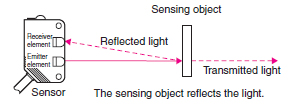Understanding Fiber Optic’s Role in Photoelectric Sensing
Photoelectric sensors and fiber optic sensors are very similar in a lot of ways, but which one is superior in function and durability, and under what conditions might one be preferred?
Optical Sensing
Detecting the presence of materials or parts is an essential process of automation. Methods or sequences cannot progress properly without confirmation that the object is present or not present. Optical sensing uses a single wavelength of light to determine if an object is within the rated sensing field of view.

Figure 1. Demonstration of light transmitted through a coiled fiber optic cable. Image used courtesy of Control.com's Director of Engineering Content and his junior assistant
This style of sensing comes in three variations: through-beam, retro-reflective, and diffuse. All Three of these sensors output a single digital on or off signal, this signal can then be used in a PLC or relay to determine the presence or absence of an object.
Through-Beam
This style of sensor consists of an emitter and receiver, the emitter sends out a beam of light that the receiver detects. If an object blocks the receiver, the signal is lost. Then once the object leaves, the light is once again detected at the receiver.

Figure 2. Through-beam optical sensor. Image used courtesy of Omron
These sensors work well in applications with long ranges and have a high gain which works well in dusty or foggy environments. Alignment of sensors can be time-consuming and vibrations can cause alignment to drift over time.
Retro-Reflective
A retro-reflective sensor still has an emitter but uses a reflector to bounce the light back to the emitter. Like the through-beam, when an object blocks the light, the sensor no longer outputs a signal.

Figure 3. Retro-reflective optical sensor. Image used courtesy of Omron
These sensors work well in applications where the color or angle of an object needs to be detected. For example, a retro-reflector sensor can detect transparent objects such as plastic or glass. These sensors work best at longer ranges, closer ranges will not detect objects at all.
Diffuse
This style of sensor has only one component and relies on the beam bouncing off the part and returning back to the sensing portion of the sensor. There are no reflectors or receivers required for the diffuse sensor.

Figure 4. Diffuse beam optical sensor. Image used courtesy of Omron
These sensors are great for closer ranges, have a very fast response time, and work well with small parts. The surface finish of the part can have an impact on the detection distance and the response time. Typically, the range of a diffuse sensor needs to be configured before operation.
Fiber Optic Sensing
Similar to the photoelectric sensor methods described above, a fiber optic sensor uses light to detect the presence of an object. The difference is that a fiber optic sensor uses a special fiber optic cable to transmit the light from a more remote mounting surface to and from the amplifier (sensor body). This can help minimize harmful effects from the equipment, such as vibration, electrical or explosion hazards, and humidity.

Figure 5. Close-up view of the inside of a fiber optic bundle. Image used courtesy of Wikipedia
Fiber Optic Cable
A fiber optic cable is a very thin filament that is drawn from molten glass or plastic. This hair-like substance has the ability to transmit light with very low attenuation. Fiber optic cable is commonly used in the telecommunications industry. In fact, a special fiber optic cable spans across the Atlantic Ocean to provide internet and phone communications between North America and Europe. This application combines multiple fibers to transmit multiple light sources over a great distance. In automation applications, fiber optic is used a bit differently but with the same ‘conductive’ medium.

Figure 6. Fiber optic concept applied to a photoelectric sensor. Image courtesy of Omron
Fiber Optic Sensors
In the realm of automation, fiber optic cables are used to transmit light through as few filaments as possible and usually over a fairly short distance. A typical fiber optic sensor will consist of an amplifier that handles emitting the light and displaying the received light intensity. The fiber head itself may be a single head or a split (Y-shaped) cable to accommodate both sending and receiving signals, as seen in the lower part of Fig 6.
There are single fiber heads that act like a diffuse sensor, and there are through-beam-like heads that consist of an emitter and receiver. The fiber heads can be mounted in many different ways and typically have a standard-sized thread on the body of the head. Some heads are cylindrical, while some are square or mounted in a small bolt. Some manufacturers even have miniaturized sensors that measure less than 1 mm in diameter.

Figure 7. A wide variety of fiber optic sensors. Image used courtesy of Keyence
Applications of Fiber Optic Sensors
A fiber optic sensor can be used in virtually any application where a photoelectric sensor is used because they both use the same principle to detect objects. The advantage of the fiber optic sensor lies in the cable itself. The cable that carries the light doesn’t have any electronics, it can withstand high temperatures and excessive pressures. In some cases, the cable can be embedded in plastic or concrete while the amplifier is located elsewhere. The fiber head is typically very small and has solid mounting features. This allows the cable and head to be mounted in tight spaces where a typical retro-reflective sensor would never fit.
With the amplifiers being placed in centralized locations, manufacturers have added the ability to add field bus connections directly on the amplifier, reducing the wiring of discrete inputs and outputs. If cost is not an option, the fiber optic sensor offers a superior way of detecting objects under adverse machine and environmental conditions.
Featured image used courtesy of Adobe Stock






